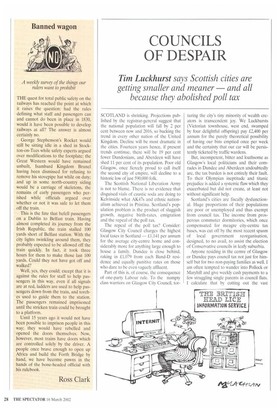Banned wagon
A weeky survey of the things our rulers want to prohibit
THE quest for total public safety on the railways has reached the point at which it raises the question: had the rules defining what staff and passengers can and cannot do been in place in 1830, would it have been possible to develop railways at all? The answer is almost certainly no.
George Stephenson's Rocket would still be sitting idle in a shed in Stockton-on-Tees while safety experts argued over modifications to the footplate; the Great Western would have remained unbuilt, Isambard Kingdom Brunel having been dismissed for refusing to remove his stovepipe hat while on duty; and up in some north-country siding would be a carriage of skeletons, the remains of early passengers who perished while officials argued over whether or not it was safe to let them off the train.
This is the fate that befell passengers on a Dublin to Belfast train. Having almost completed its journey from the Irish Republic, the train stalled 100 yards short of Belfast station. With the city lights twinkling around them, they probably expected to be allowed off the train quickly. In fact, it took three hours for them to make those last 100 yards. Could they not have got off and walked?
Well, yes, they could; except that it is against the rules for staff to help passengers in this way, even if all signals are at red, ladders are used to help passengers down from the train, and torches used to guide them to the station. The passengers remained imprisoned until the stricken train could be brought to a platform.
Until 15 years ago it would not have been possible to imprison people in this way; they would have rebelled and opened the doors themselves. Now, however, most trains have doors which are controlled solely by the driver. A people once brave enough to open up Africa and build the Forth Bridge by hand, we have become pawns in the hands of the bone-headed official with his rulebook.
Ross Clark
















































































 Previous page
Previous page